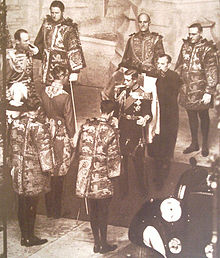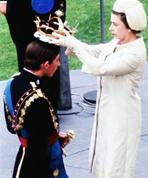
Llandaff Cathedral, seat of the Bishop of Llandaff, Head of the Church of Wales. The Queen attended a Thanksgiving service for her Diamond Jubilee there yesterday.
Continuing their busy schedule of Diamond Jubilee visits in the United Kingdom, Queen Elizabeth II and Prince Philip, Duke of Edinburgh toured South Wales on April 26 and 27, visiting Cardiff, Llandaff and Margam yesterday, and Eberfan, Ebbw Vale and Glanusk Park today. In a speech delivered at Ebbe Vale, the Queen expressed her admiration for the inhabitants who have faced economic hardships in recent decades as manufacturing jobs moved away from the area.
Her Majesty stated, “You have been witnesses to many of the greatest changes in Wales of recent years. My family has been coming here since the height of the Valleys’ industrial might. After the closure of the steelworks a decade ago, we have admired the fortitude and resilience of Ebbw Vale as you have tackled the social and economic struggle that followed.” The reference to the royal family’s history of visits to Ebbw Vale alludes to the significance of previous royal tours of Wales, which often highlighted the unique social and economic conditions of the region.
The relationship between the English royal family and Wales dates from the reign of Llywelyn the Great in the fourteenth century, who married King John’s illegitimate daughter Joan, and consolidated his power base in the region, claiming the title of Prince of Wales. (The marriage of Llywelyn and Joan has inspired numerous works of historical fiction, most notably Sharon Kay Penman’s novel, Here Be Dragons.) The ascendancy of the House of Gwynedd did not last and Llywelyn the Great’s grandson, Llywelyn the Last was defeated by Edward I “Longshanks” in 1282, incorporating his territory into the English kingdom.
King Edward’s son, the future Edward II was born on the Welsh campaign and was given the title Prince of Wales, which has been conferred on royal heirs to the present day. Wales was literally the birthplace of the Tudor dynasty. Henry VII was born in Pembroke Castle in 1457 to the thirteen-year-old Lancastrian heiress Margaret Beaufort, the widow of a Welsh nobleman, Owen Tudor. Queen Elizabeth II visited Pembroke Castle during a 1955 tour of North Wales that included visits to the National Library of Wales and the University in Aberystwyth.

King Edward VIII's only State Opening of Parliament in November, 1936. His subsequent visit to Wales created political tensions that fuelled popular perceptions of the Abdication Crisis.
One of the most significant royal visits to Wales in the 20th century was Edward VIII’s November, 1936 visit to the Bessemer Steel Works at Dowlais, which had reduced its workforce during the Great Depression. The King gave a moving speech expressing his sympathy for the plight of the Welsh steelworkers, stating, “These works brought all these people here. Something must be done to find them work.” Edward VIII’s call for something to be done increased his popularity with his subjects but alarmed members of his government who feared that he was disregarding the impartiality expected of a constitutional monarch.The tour of Wales shaped popular opinion of the Abdication Crisis, fuelling speculation that Edward VIII’s government was eager to replace him with a more tractable successor.
Another famous royal visit to Wales occurred in October, 1981, when Prince Charles and his new wife, Princess Diana undertook their first official tour as a married couple. Although Diana was suffering from morning sickness throughout the trip, she charmed the enormous crowds who gathered on the route to Caernarvon Castle to greet the royal couple. The Princess’s approach to royal walkabouts was widely admired as she thanked flower presenters in Welsh and embraced a child with spina bifida.
Although the castle was the place where Charles had been invested by the Queen as Prince of Wales, he was overshadowed by his wife, commenting during the 1981 tour, “At least I know my place know. I’m nothing more than a carrier of flowers for my wife.” Diana’s ability to upstage Charles on royal visits would create lasting tensions within their marriage.
The Jubilee visit of Queen Elizabeth II and Prince Philip, Duke of Edinburgh to Wales is the latest significant royal milestone to be celebrated in this historic region. The royal family has longstanding ties to Wales and visits there have had a lasting influence on the history of the monarchy.

